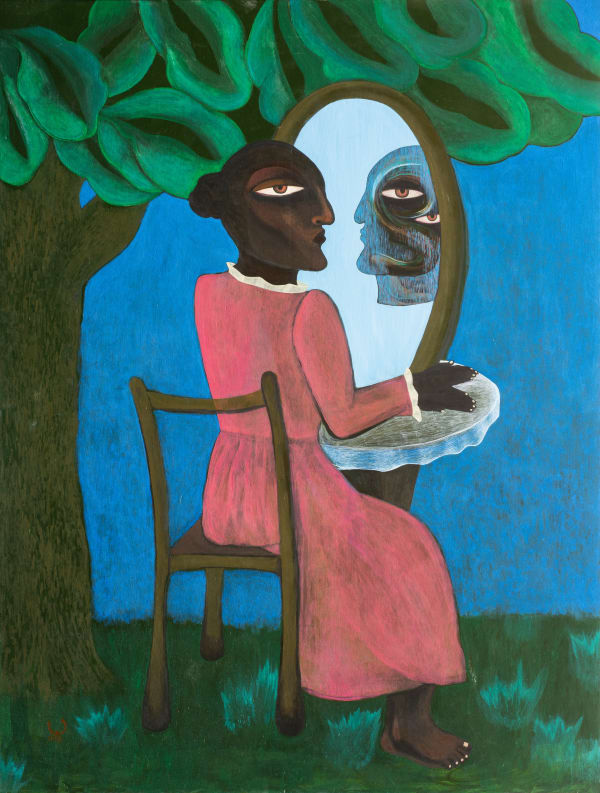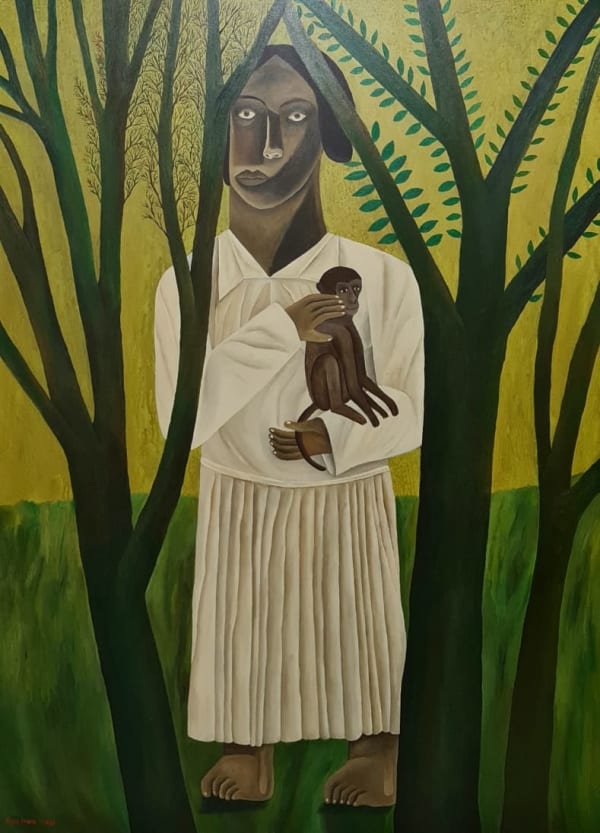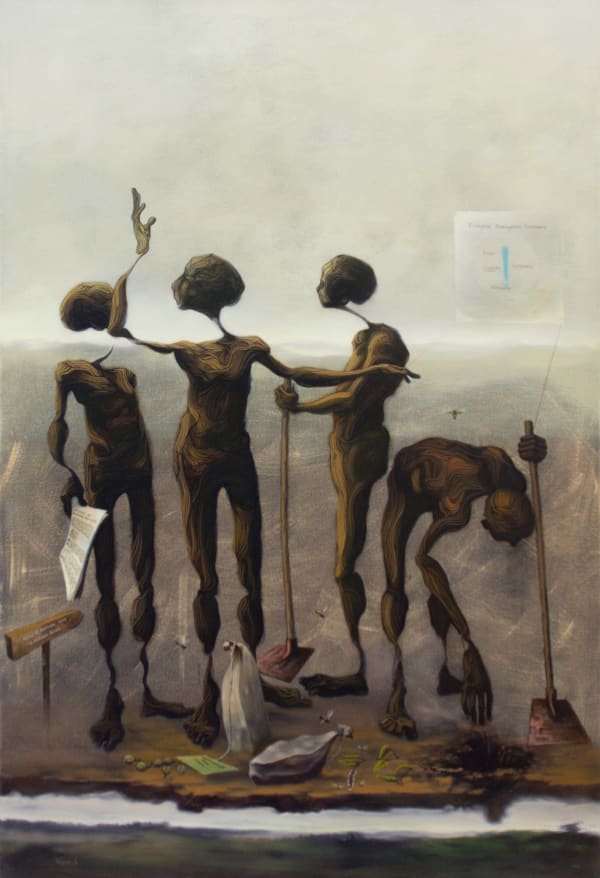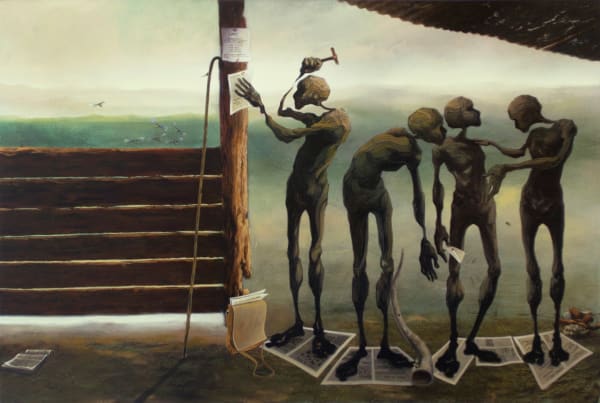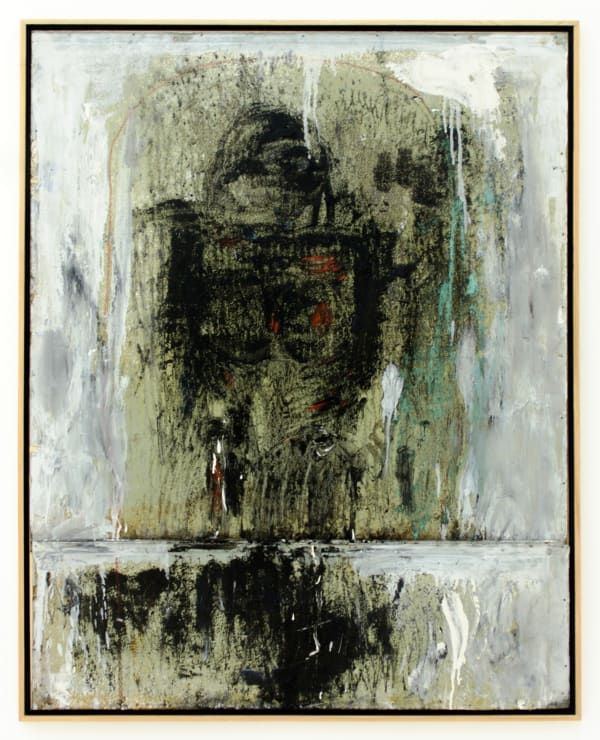East African Encounters: Gallery 12, Cromwell Place, London
We joined Cromwell Place in 2019, with the intention to extend our geographical reach and to be able to hold regular exhibitions in London and give artists more international visibility. Finally in October 2021 we are able to hold our first exhibition which is an overview of some of our most interesting artists from Kenya, Uganda, Sudan and Egypt.
For more information please contact: Danda Jaroljmek, Director,
danda@circleartagency.com, +254722672938 (and +44 7802733226 until October 21st)
www.circleartagency.com, www.cromwellplace.com
Souad Abdlrassoul currently lives and works in Cairo. Her artistic practice spans various media; drawing, painting, sculpture and graphic design. Working between the abstract and figurative, she connects human and animal figures to the Earth believing we are a part of it. Her metamorphosed figures do not seek to depict physical beauty but attempt to reflect on the connections between the human race and the natural elements of life; earth, metal, animals and plants. Tree-like figures with branching veins and arteries, and giant insect-like creatures merge on her canvases to remind the viewer of the vital bond between our internal lives and the exterior world we live in. Abdlrassoul re-conceptualizes the way we perceive space and re-purposes notions of form, science and nature into something strikingly personal, she exalts in the feminine, the emotional and nature. Throughout her work, she tells stories, sometimes using myths and legends that we recognise, to draw attention to how women are forced to evolve and grow in an environment that is oppressive and that restricts the life choices. She questions the role of women in society and cultural history in an unusual and disruptive way.
Abdlrassoul graduated with a BFA in 1998, completed her master’s degree in History of Art in 2005, and in 2012 she completed her PhD in Modern Art History. Since 1998 she has exhibited frequently in group and solo exhibitions in Cairo as well as shows in Nairobi, Beirut and the USA. She has also exhibited at international art fairs in London and Marrakech. She is also an illustrator children’s books, and conducts artistic workshops for children in Cairo.
Salah Elmur (Sudanese, b. 1966)
Elmur’s work is composed of a fertile visual vocabulary that draws on his social and cultural heritage. He draws on his observations of life and memories of his childhood and youth for the scenes, situations and impressions that he depicts in his work. Heavy symbolism, a tendency towards vivid colour combinations, and distortion of natural figures and proportions are some of the markers of Elmur’s painting.
Inspired by the many photographs he has collected from his family’s photography studio, Elmur’s paintings often emulate formal portrait settings with additional elements that complement but also unsettle the mood in his paintings. Plants and animals share the frame with the human subjects, limbs are shortened and proportions are distorted, altering the relationships between various objects and figures in the frame. All these elements are combined in a somewhat surrealistic swirl of memory, and the resulting paintings are tender, intimate vignettes of human relationships, the rituals and poetry of daily life and folklore.
Salah Elmur originally studied Graphic Design at the College of Fine and Applied Art, Sudan University, Khartoum. With a career spanning three decades, he has spent years travelling and living across East Africa and the Middle East and has participated in group and solo exhibitions in East Africa, the Middle East, Europe and America since 1985. Elmur has also published 12 children’s books and is a successful filmmaker; directing six short documentaries and fantasy films, which have been shown at international film festivals. In February 2018, the Sharjah Art Museum in the UAE held Fragrances of the Forest and Photos, a retrospective of Elmur’s work, followed by Forests and Spirits, an exhibition at the Saatchi Gallery in London alongside two luminaries of Sudanese modernism, Kamala Ishaaq, and Ibrahim El Salahi. He participated in a group exhibition at the British National Museum and his work is collected widely and is included in the permanent collection of the Museum of African Contemporary Art Al Maaden (MACAAL) in Marrakech, the Sharjah Art Foundation (SAF), Zeitz MOCAA, Minneapolis Institute of Art, Weisman Art Museum and the Pompidou Centre, Paris.
Miska Mohmmed (Sudanese b. 1995)
Miska Mohmmed creates lush, effervescent paintings inspired by the meeting of the natural and the man-made, as observed in her home city, Khartoum. Working primarily in acrylics and oils, her works feature undulating gestures let loose across the picture plane, with subtle colour gradations suggesting an interplay between land, water, air, flora and fauna. Mohmmed trained as a painter and for a long time, practiced plein air painting, an experience which has informed her exploration of nature and the contrast between the quietude of open, unpopulated areas with the bustle and energy of crowded urban spaces. Her ingenious use of colour and line, combined with semi-abstract forms manifests the physical terrains that inform the work as well as their energy and atmosphere. Her works are equally soothing and invigorating, pulsing with life and exuding a psychic pull on the viewer.
“When you look at my paintings, even without any living beings present, you feel the energy of these places. Sometimes I find myself in a crowded city, and sometimes on a quiet beach looking at a calm ocean. I am testing the bustle of the city against the tranquility of nature.” - Miska Mohmmed
Miska Mohmmed received a BFA in painting from the College of Fine and Applied Arts, Sudan University in 2016. She has shown her work in various venues in Sudan including the Rashid Diab Arts Centre and the French Cultural Centre. Outside Sudan, Mohmmed has exhibited in Nairobi, Cairo and Lagos and participated in international symposia in Egypt and Tunisia. In 2017, she was one of the artists in the Khartoum Contemporary group exhibition at Circle Art Gallery, and her work has since come up for auction twice in the annual Art Auction East Africa. In September 2021, Mohmmed had her first solo exhibition The Magic of Forgotten Places at Circle in Nairobi.
Dickens Otieno (Kenyan, b. 1979)
Dickens Otieno’s tapestries use and draws attention to the potential beauty in objects that would otherwise be dismissed as useless and discarded. He shreds aluminium cans and weaves them into tapestries, in a process informed by the weaving of natural materials such as papyrus, raffia, or palm that he observed growing up. His mother was a tailor and he spent many hours in her workshop amongst lesos and kitenges, whose colours and patterns have since influenced his aesthetic. This engagement with fabrics grows from an interest in the way pattern, colour and iconography are used to imbue functional objects with meaning and identity. Otieno draws heavily on his immediate physical surroundings, particularly the urban environment in his native Nairobi to create his compositions. Objects piled high in markets, the constantly shifting skyline, the pockets of nature in the concrete and steel haze of Nairobi – these are the sources of Otieno’s inhttps://circleartagency.com/online-gallery/exhibitions/recent-exhibition/dickens-otieno-mabati-tailor/spiration for his richly hued, increasingly sculptural compositions.
Otieno has participated in numerous group exhibitions locally and internationally. Recent exhibitions include: See Here, Old Neals Auction House, Nottingham, 2018; Africa/Africa, Total Arts Courtyard Gallery, Al Quoz, Dubai, 2018; Young Guns, Circle Art Gallery, Nairobi, 2017; The Third Dimension, Circle Art Gallery, 2016; UNI-FORM MULTI-FORM, Roots Contemporary, Nairobi, 2016; Paint and Metal, National Museum in Nairobi, 2016. His recent residencies include the Tilleard Artist Residency in Lamu, Kenya, and a 6-week fellowship in Italy at the Civitella Ranieri Foundation. His most recent exhibition was Mabati Tailor, a solo exhibition at Circle Art Gallery in 2020 and he has a solo show in October in Los Angeles. Also in October with Circle, he will be part of a group show in London at Cromwell Place and 1-54 Art Fair.
Boniface Maina (Kenyan b. 1987)
Maina works predominantly in painting and drawing. He is an observer of human action and emotion, and in his work, he investigates the inconsistencies and conflicts inherent in human interactions with one another and the world around them. In his current work Maina explores the deleterious effect of human activity and globalised industry on the natural environment. Maina pays particular attention to environmental threats witnessed in his native Kenya, including large scale logging and deforestation, flooding, and contamination of water and air by industrial waste. The paintings feature characters adrift in this , their actions alternation between half-hearted protest and resignation to their fate. He also introduces visual cues in the form of text, signage, icons which name or allude to the organisations (public as well as private) responsible for much of this damage. These dystopias are, in some instances, contrasted with natural, unblemished idylls introduced through narrow sections often along the bottom part of the compositions, offering a view of the world as it is (or where it's headed) but also of what it once was.
Boniface Maina was born in Nanyuki. He lives and works in Nairobi where he earned his diploma in Art and Design from the YMCA National Training Institute in 2008. In 2013 he, along with David Thuku and Michel Musyoka founded the Brush Tu artists’ collective, a communal studio space. He has previously had solo exhibitions at The Art Space in Nairobi (Line of Inquiry, 2016) and the Nairobi Gallery (Transitions, 2017). He has participated in group exhibitions in Nairobi, Lagos, Dubai, and Venice. His work has also been exhibited at international art fairs; AKAA Paris, FNB Jo’burg Art Fair, and Art X Lagos.
Lawrence 'Shabu' Mwangi (Kenyan b. 1985)
Shabu has been a practising artist since 2003. His practice focuses on the effects of structural and historical violence, and different forms on marginalization on the individual and collective psyche. Shabu’s paintings are considerations of societal and cultural fissures. His most recent work traces an ongoing personal journey of striving to understand the balance between the two things that drive us, love and pain and how we react in different ways depending on which of the two is dominant. Shabu’s work has previously dealt with questions of collective suffering, and the effects that inequality, marginalization, and other forms of structural violence have on communities. In this new body of work, he has turned his gaze inwards, focusing on an examination of the self. He asks himself questions about how he sees the people around him and his interactions with them.
“We are all connected to one another, and none of us is truly free from our collective struggles. I have a family, I have a clan, I have a tribe…”
Mwangi has participated in workshops and residency programs both locally and internationally. His most recent exhibitions were The Sources of our seas, a solo show at Circle Art Gallery in 2021, The Man with Two Shadows (2020), an online exhibition with Circle Art Gallery, and Yawning for Power, 2019, a solo exhibition with Tilleard Projects. Other shows include The Stateless and Freedom, Flight, Refuge(2017), Circle Art Gallery, Nairobi; Art Transposition (2017), Nairobi-Kampala-Hamburg (2017), LKB Gallery, Hamburg; Pop-Up Africa, (2017), GAFRA, London; Out of the Slum (2012), Essen, Germany; and various other group and solo exhibitions. He has also participated residencies in Kenya, Germany and Italy. He formed the Wajukuu Art Centre in 2004 with fellow artists to mentor young people in his community of Mukuru and the collective have been selected to participate in the next edition of Documenta in 2022. Shabu will organize a children’s programme during this exhibition, which will be included in Documenta’s ‘Art in Education’ programme.
Agnes Waruguru (Kenyan b. 1994)
Agnes Waruguru received her BFA from the Savannah College of Art and Design in 2017. She returned to Nairobi where she is currently based, and has since participated in group exhibitions at Circle Art Gallery and at One Off Contemporary. In 2020, Waruguru participated in the inaugural edition of the Stellenbosch Triennale, in South Africa; her work was included in On the Cusp, a section dedicated to “unraveling the creative talents of tomorrow. She has exhibited in Kenya, South Africa, the USA, and France. She has participated in residencies in Lamu, Kenya and Sydney, Australia.
Donald Wasswa (Ugandan, b. 1984)
Donald Wasswa is a Ugandan contemporary artist based in Kampala where he runs Artpunch Studio. Wasswa’s work encourages conversations about the future of mankind looking at the influence of science and technology in modern societies. He studies the process of transformation with his primary focus on humans versus a given environment, social interactions and the nature of communication involved. Wasswa uses actual events to influence his research which rely on spontaneous encounters with natural or found objects. These objects are carriers of memories of places that he claims as art materials. The objects later suffer various forms of interference by carving, assembling and arranging, which result into Sculptures, 3D paintings, at times installations. Wasswa imagines the secret lives of man-made objects and how they determine the future humans. Wasswa studied Sculpture at Kyambogo University. His practice has evolved to encompass sculpture, painting and performance. He was the 2016 recipient of the merit award in the Absa L’Atelier competition. He has participated in solo and group exhibitions in Uganda and abroad, including: Zikunta, Kampala, 2016; To Live is to Become, Afriart Gallery, Kampala, 2017; and, in 2019, he participated in the inaugural of the International Biennial of Sculpture of Ouagadogou.
Jackie Karuti ( Kenyan, b. 1987)
Jackie Karuti’s practice is largely experimental and employs the use of new media through drawings, video, installations and performance art. Her work is founded on ideas around knowledge production & accessibility as well as the depths of possibility enabled by radical imagination. Karuti is an alumnus of Àsìko, a roaming Pan African art school established by the late Bisi Silva, designed to redress the frequently outdated or non-existent artistic and curatorial curricula at tertiary institutions across Africa. Karuti’s work has been exhibited widely most recently in 2019 at The Lofoten International Art Festival in Svolvær, Norway as well as at the Dak’Art Biennial in Senegal in 2018. Other projects that respond to her practice include programming the Out Film Festival in Nairobi 2016-2018 and her online workspace, I’ve Been Working on Some Magic . She was a 2019 resident artist at the WIELS Contemporary Art Center in Brussels.
In 2017, Jackie Karuti received the 2Young Artist Award at the Cape Town Art Fair. In 2020 she was awarded the Henrike Grohs Art Award which includes a publication on her work to be released in late 2021; and she is the just-announced 2021 recipient of the Follow - Fluxus scholarship, awarded by Kunstverein Wiesbaden.
More information about Karuti's practice can be found on her website: Third Room Studios
Tahir Karmali (Kenyan b. 1987)
Tahir Karmali is primarily an investigator of materials and their life cycle from their origins to their uses – as currency, as markers of cultural identity, or as exploitable artifact - and the associations that they bear. He is invested in transforming these materials into varying formats (sculptural installations, prints, textile works) that are deceptively attractive, as an art form, allowing the viewers to engage with them, first as primary material, before a layer of trauma (of migration, of displacement) reveals itself slowly. His work is based not only on his own physical experience of moving between borders, and globally diverse cultures, but also on how certain elemental materials move through these same routes and are thus transformed per their use value in each space, including within the art world.
Paradise (2019) is a recent series of works that reflect on the time my family spent in the Seychelles, where my mother is from. Each image is set in an idyllic landscape, yet the works also engage with notions of death, frustration, fatigue, longing, and fantasy. The works have a deceptive beauty which belies the haunting and longing undercurrent in the work. The works are made with a low-waste screen-printing process on organic fair-trade cotton canvas and dyed with organic natural dyes. The choice of material and process is informed by a need to be environmentally responsible; thinking as well of the Seychelles as one of the places affected by the global climate crisis.
In Grid Encountering natural Form (2021), Karmali turns his gaze towards spaces that are built/designed as temporary living spaces for displaced people. Struck by the similarities in their architecture, he's created a series of screenprints that overlay aerial photographs (whole or partial) of these different sites, calling attention to similarities in their designs and architecture across different locales.
In the artist's words 'These prints attempt to express the tenuous relationship we have with Earth as we watch communities and landscapes disintegrate. The three satellite images are of refugees camps in Kenya; Kakuma and Dadaab (Dagahaley and Hagadera). The works specifically discuss the gridded format of these settlements and how they formally interact with these arid landscapes. For the most part, a majority of the refugees are moving from a more organic/circular settlement to this regimented gridded format. In one of the images, you can see a comparison of the circular village settlement (top) and the gridded refugee camps (bottom) - here you can see the contrast between the two in how they interact with the landscape. These screenprints are a result of my research on migration as a result of climate degradation. There is an increasing amount of environmental migrants in Kenya due to desertification and extreme drought.
A majority of these refugee camps are also situated in dangerous and arid areas which requires them to depend on aid. As it stands under the Geneva convention an environmental migrant cannot seek asylum. They have little chance of leaving the camps and will likely spend their lives in the camps. As the world faces climate change these camps are a precursor to what will eventually happen globally. A majority of people affected by this did little to contribute to climate change and will be beholden to lines drawn by our colonial history.'
